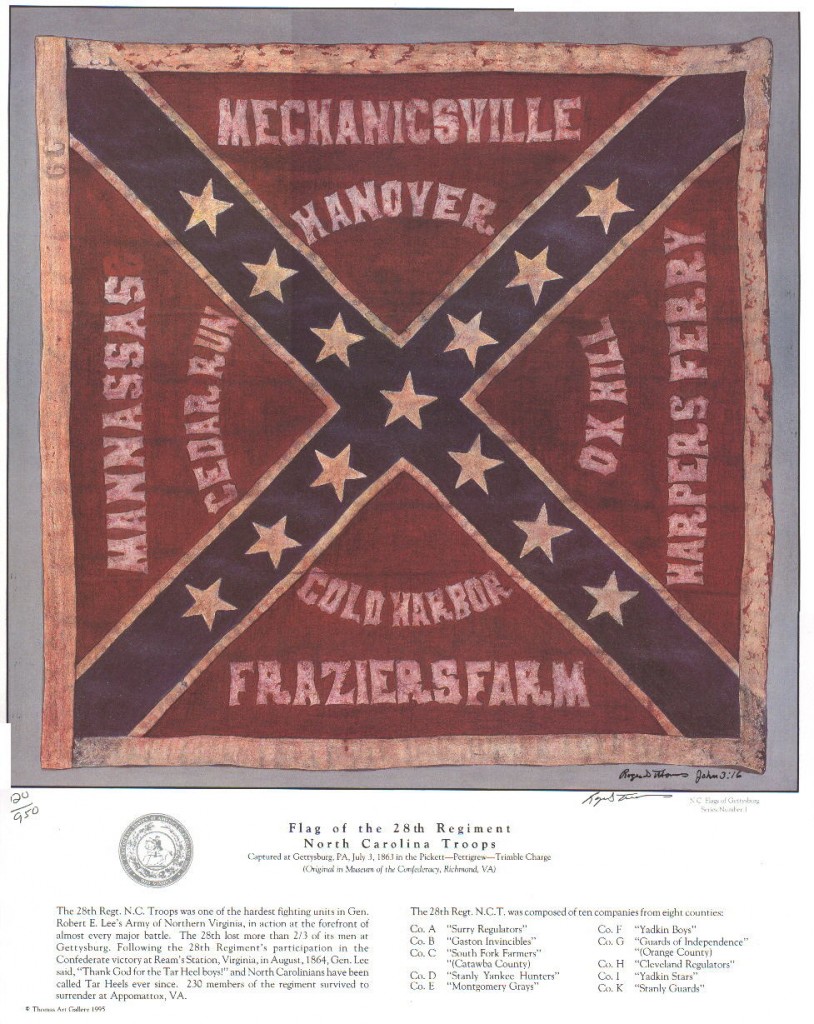By: John Hoyle Burleson
Lane’s Brigade, composed of NC soldiers of A.P. Hill’s Light Division, was one of Gen. Lee’s Army of Northern Virginia’s finest. This brigade probably saw more action and participated in more tough battles than any other.
At Sharpsburg, Maryland (also know as Antietam), Gen. Lee’s 37,000 men opposed by 87,000 union troops, was whipped and his back was to the Potomac River. Gen. A.P. Hill, holding at Harper’s Ferry, Va, was requested to send help and save Lee’s and Jackson”s armies from certain destruction. Hill put his “light division” on a 17-mile forced march. They were still at a trot when they fired their first volleys into the oncoming union ranks. This halted the Yankee attack. As more troops arrived and more volleys were fired, the union attack became a retreat. Lee and Jackson were saved.
The lead regiments were the 28th, 37th, and 33rd, North Carolina, commanded by Lawrence O’Brian Branch of Wake County, NC. He died leading his troops and directing their fire into the union ranks. James Henry Lane took over and the brigade would come to be known as Lane’s Brigade for evermore. Cousins Ebin Burleson, Joseph Benjamin Burleson, and John Wesley Burleson were among the ranks of this brigade.
When both Gen. Robert E. Lee and Stonewall Jackson lay on their deathbeds, their last words were were the same, “Tell A.P. Hill to come up.” The Carolina boys of A.P. Hill’s Light Division, Lane’s Brigade, never failed them in life and they were on both Lee’s and Jackson’s minds at their deaths.
At Fredericksburg, when the union troops penetrated Lee’s line, it was Lane’s Brigade that refused to retreat and they turned ninety degrees and attacked to fill the gap and stop the breach in the line. At Spotsylvania Courthouse when Johnson’s division was routed and captured at the Bloody Angle, it was Lane’s Brigade that again stood fast and counter attacked to restore the Confederate line. The same happened at the Crater in the Petersburg line in 1864. Lee’s and Jackson’s most successful battle was at Chancellorsville where Lane lost a third of his entire brigade. This was the heaviest loss of all of Lee’s army.
A.P. Hill’s Corp and Lane’s Brigade may not have been the last thought on Gen. U.S. Grant’s mind on his death bed, but they were the first consideration in Grant’s plan to crush Gen. Lee in
April 1865 to end the war. Grant knew that if he could overpower the best of Hill’s troop, the rest of Lee’s army would have to retreat or surrender. By April 1865, Grant had the men and was willing to sacrifice them. After pushing Gen. Pickett away with very little opposition on April1, Grant was ready to deliver the final blow to Lee. He ordered his spearhead to strike Lane’s Brigade at 4:40 AM, 2 April on the Boydton Road. Grant attacked with three union corps, outnumbering Lane twenty to one.
Today you can visit the exact spot where Grant made his breach in the Confederate line. It is located in Pamplin Park outside Petersburg, VA. The break came in the 28th NC defense. You can stand in the rifle pits just as Ebin and Adam Burleson stood. You can also look to your front and see the ground where 1,100 union soldiers died during the first 15 minutes of their attack on Lane’s North Carolina troops. Only after exhausting their ammo did the 28th allow the break. Ebin had fought in all of Lee’s campaigns since March 15, 1862, but was captured here. He was not released from Point Lookout Prison until three months after the surrender at Appomatox.
Survivors would rally at Ft. Gregg to their rear. This is where Grant’s spearhead was stalled untill noon. History credits the defense with saving Lee’s crushed army and giving the government at Richmond time to evacuate to the south. Fighting at Ft. Gregg was furious, the Confederates fought with clubbed rifles, bricks, and rocks. Men would light explosives cannonballs by hand and throw them over the ramparts. Only a handful would survive at Ft. Gregg, while hundreds died.
Many Stanly County sons served in Company K of the 28th NC, known as the “Stanly Guards”, including Ebin Burleson. Company D of the 28th NC known as the “Stanly Yankee Hunters”, contained cousins Adam Burleson and John Wesley Burleson. Joseph Benjamin Burleyson served in Company C of the 37th NC of Lane’s Brigade, also known as the Mecklenburg Wide Awakes”.
On July 3, 1863, Gen. Lane led his brigade all the way to the rock wall at Gettysburg, but had to fall back. On the wall the 28th NC lost their regimental flag to the 126th NY Infantry. Ebin and John Wesley were among the lucky ones to return alive to the Confederate cannons to take up a defensive position. Joseph Benjamin was left on the field wounded for the third time and captured by the Yankees. History credits Gen. Lane’s Brigade as the only unit to fight to the rock wall, reform on their broken retreat on the battlefield and march back under fire, all under the control of their commanding offficer Gen. James Henry Lane. Loyalty and trust like this explains the respect they had from both the gray and the blue. Northern newspapers used to say that when the army of Stonewall Jackson was near, women and children would cry. But in all actuality, when A.P. Hill’s Carolina Boys were near, the Yankee soldiers knew they would soon be in a fight for their life sooner more than later.

